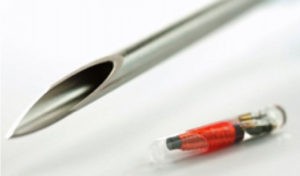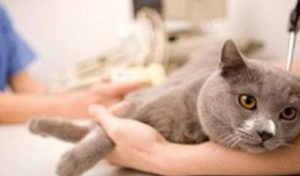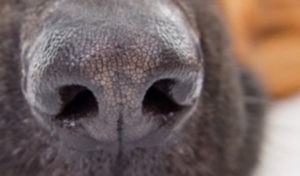Microchipping Your Pet
 What is a pet microchip?
What is a pet microchip?
Microchips used in pets are an excellent way of providing permanent identification for your pet. These microchip implants are no bigger than a grain of rice and store a unique identification number that can be read by a micro chip scanner.
How is the microchip put into your pet?
Microchips are inserted underneath the skin in the subcutaneous tissue between your pet’s shoulder blades. Before insertion the sterile microchip is scanned in the package to confirm that the identification code is the same as what is shown on the package. Next, the loose skin between the shoulder blades is gently pulled up and the needle is quickly inserted and the microchip is placed into the tissue. After insertion the microchip is scanned to confirm proper placement and that the chip is reading properly.
How long does it take?
The procedure is fast, taking only a matter of seconds to insert the chip. It takes more time to complete the microchip paper work than it does to implant the chip.
Is it painful to my pet?
Getting microchipped is about as painful as having blood drawn. Although the needle is quite large it is extremely sharp and can usually be inserted without incident in animals that are awake. Some clients choose to have their pet microchipped at the same time that they are spayed or neutered so that they are anesthetized for the injected but this is not necessary; microchips can be implanted at any time that is convenient.
I’ve heard that microchips can harm my pet. Is this true?
A Microchip is a passive RFID (Radio Frequency Identification). This means that with no internal power source it will remain inactive until it is powered by a scanner. When scanned, the only thing transmitted is the identification number which can be used to look up owner information in a database. The components of the microchip itself are encased in a biocompatible material that is non-toxic and will not cause any allergic reactions as long we the chip is implanted properly.
My pet never goes outdoors. Do they need a microchip?
Although most indoor animals stay indoors there is always a chance that they may get out. Someone may open the door at the wrong time, leave the back gate open by accident or your pet may be able to get out through a loose window screen.
My pet already wears a collar with a tag on it. Do they need a microchip?
If your cat gets lost or picked up by animal control, the more types of identification they have the better. Although collars are very visible forms of identification they can fall off or be removed. Tags on collars also fade over time and become hard to read, they are not a permanent form of identification.
My pet has a tattoo. Do they need a microchip?
While tattoos are permanent they are not always reliable identification. The first problem with tattoos is that they become faded over time and hard to read. The second, more important problem with tattoos is that there is no common database for them like for microchips so owner information can be difficult to track down. Microchips cannot be misread or tampered with; this makes them a reliable form of identification.
Once my pet has been microchipped, is there anything else I need to do?
Yes, microchips must be registered with the appropriate agency. Your veterinarian will provide you with the documents and contact information for these agencies. If you don’t provide your contact information the procedure will be pointless so many veterinarians will submit the paper work for you.
Although the microchip will continue to function throughout your pet’s life without any maintenance, it is important to ensure your contact information is kept current.
How will the microchip help my pet get home?
Most animal shelters, pet stores and veterinary clinics have microchip scanners. If your pet is found and brought into one of these locations they will be scanned for a microchip number. The number can be looked up in a database and used to contact the owner of the lost pet.
Is there anything else I should know?
Millions of pets get lost every year, and animals without a microchip have a less than 5% chance of being reunited with their owners. Pets with microchips are 20 times more likely to be reunited with their families. To help keep your pet as safe as possible please ensure you keep your contact information current. In the event that your pet does get lost posting flyers with a current photo of your pet and contacting your local veterinarians and animal shelters will also help to ensure their safe return.
This blog post was written by McQueen Animal Hospital, a veterinary clinic in Brampton providing quality affordable veterinary care



 Cats are mysterious creatures by nature, which can make it very difficult for owners to tell if they are sick. As a general rule: if your cat is hiding more than usual it may be time to see veterinary care. Cats are very good at hiding their clinical signs of disease until it becomes very severe. Here are a few signs of illness you can look for in your cat:
Cats are mysterious creatures by nature, which can make it very difficult for owners to tell if they are sick. As a general rule: if your cat is hiding more than usual it may be time to see veterinary care. Cats are very good at hiding their clinical signs of disease until it becomes very severe. Here are a few signs of illness you can look for in your cat:
 It is a common misconception that a dry nose means your dog is sick. Owners frequently come into the clinic saying, “His nose was dry, so I knew something was wrong.” While it’s fantastic that you’re observing your dog so carefully, a dry or even a wet nose is not always an indicator of illness.
It is a common misconception that a dry nose means your dog is sick. Owners frequently come into the clinic saying, “His nose was dry, so I knew something was wrong.” While it’s fantastic that you’re observing your dog so carefully, a dry or even a wet nose is not always an indicator of illness.